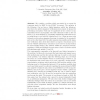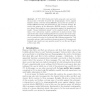25 search results - page 4 / 5 » Public-Key Encryption with Non-interactive Opening |
STOC
2005
ACM
14 years 10 months ago
2005
ACM
Our main result is a reduction from worst-case lattice problems such as GAPSVP and SIVP to a certain learning problem. This learning problem is a natural extension of the `learnin...
ASIACRYPT
2000
Springer
14 years 2 months ago
2000
Springer
We consider a problem which was stated in a request for comments made by NIST in the FIPS97 document. The question is the following: Can we have a digital signature public key infr...
ICALP
2005
Springer
14 years 3 months ago
2005
Springer
At TCC 2005, Backes and Cachin proposed a new and very strong notion of security for public key steganography: secrecy against adaptive chosen covertext attack (SS-CCA); and posed ...
SCN
2010
Springer
13 years 8 months ago
2010
Springer
Exposure of a secret key is a significant threat in practice. As a notion of security against key exposure, Dodis et al. advocated key-insulated security, and proposed concrete k...
EUROCRYPT
2009
Springer
14 years 10 months ago
2009
Springer
A group key agreement (GKA) protocol allows a set of users to establish a common secret via open networks. Observing that a major goal of GKAs for most applications is to establish...


